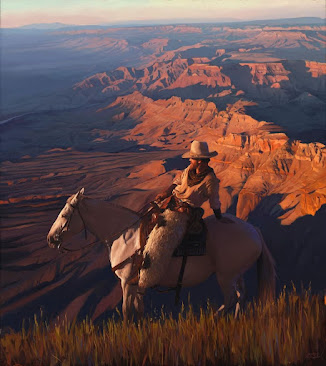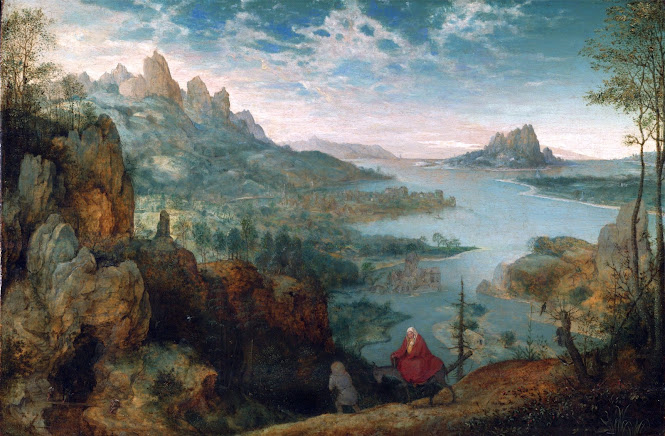Early Modern Exhibit
I will focus on the influences of the great depression as seen in the following three works, exploring the moods and modality of the art of this unique time in history. I am especially interested in black and white colors in printmaking and photography, a theme evident in the pieces I chose to represent this time.
Thomas Hart Benton (American, 1889–1975). Approaching Storm, 1940 Lithograph, 113/4 × 16 in. The Metropolitan Museum of Art, New York.
Right: Hale Woodruff (American, 1900–1980). View of Atlanta, 1935 Linocut, 97/8 × 8 in. The Metropolitan Museum of Art, New York.
Benton's Approaching Storm captures the tiresome labor of fieldwork, conveying the scene's mood expertly in its limited black and white colors. The distorted landscape with the odd curving horizon line harkens the viewer to the uncertainty of the great depression. The black-and-white theme creates a mood of solemn determination, the worker is strained under his load but is stable in form, which gives a sense of the hard work mentality of this period breathed from necessity. The donkeys also seem to stand guard, tied to the plow they have no choice but to keep working, this duality is seen in the split focus of the two donkeys, one looking onward the other with its head down.
Rothstein's photograph 'African African-American family at Gee's Bend, Alabama' carries a similar sense of solidarity under uncertainty. The composition is very bottom-heavy which lends itself to the stability of the hard-working family, the slightly misshapen houses and old trees give the sense of the hardships of the great depression. This photo carries a sense of reality about the great depression that isn't as evident in Approaching Storm, primarily from the nature of the photographs themselves, but also because of the composition of repetitive horizontal lines that bring stability.
Finally, Woodruff's Linocute; View of Atlanta has some of the themes we have already described. In this piece however the instability of the houses is even more prevalent, this stands in contrast to the seemingly confident figure as they make their way up the stairs. This piece would have to be my favorite of the three in the exhibit, primarily because of the use of true black and white, there are no greys. I find myself attracted to this because Woodruff has still managed to create fantastic depth with only those two colors. I feel like with those two colors Woodruff has made a very defiant painting, rich with the hard-working attitude of many Americans during the Depression, even amidst a crisis.
Art in the great depression was one of the first things to see a big hit because of its perceived lack of importance. while fundamentally art isn't a necessity, the great depression proves it can be extremely useful. The push towards more industrial design showed people running the businesses that people really cared about what their products looked like! Despite this, the uncertain times took a massive hit on artists, but thankfully from the Federal Works Progress Administration and eventually the Federal Art Project there were still ways for artists to make a living. This means that today we have art to look back on from this period.
Works Cited
National Gallery of Art. “Great Depression.” Www.nga.gov, www.nga.gov/learn/teachers/lessons-activities/uncovering-america/great-depression.html.
Rudnick, Allison. “The Art of the Great Depression.” The Metropolitan Museum of Art, 18 Sept. 2023, www.metmuseum.org/perspectives/articles/2023/9/the-art-of-the-great-depression.




Hi Fin! I also did the Great Depression for my blog, and everything seems to be in photos that it was hard for me to look at drawings. But I do agree with you that black and white in photography seems to be the main theme back then. It made the photos look so ancient to me because there weren't any colors yet, but it comes out beautifully.
ReplyDeleteHello Fin!, I love the idea of black and white it is always something interesting to look into, I feel the sadness from these photographs it captures the emotions of what those times were like. Your discriptions of each photo really caught my attention, Your second paragraph i think portrays the true reality of the great depression and the meaning behind it. I was a little confused on which picture you were trying to talk about though maybe try putting the titles under the photo directly so i can referance back to them. You did a good job relating to the theme of the great depression with your choice of photos and the history behind them.
ReplyDeleteHi Fin! The use of black, white, and grey completely makes sense for art from the Great Depression. This color scheme certainly gives off a bleak feel. I agree with your perspective on View of Atlanta, that is my favorite out of the three as well. The contrast created by the use of tone is interesting to view.
ReplyDeleteThe first piece, "Approaching Storm" reminds me of Dr. Seuss illustrations if they were much more bleak. The combination of rolling hills, the clouds, the man hunched over, the way the donkeys are drawn, and nothing being quite straight are what reminded me of Dr Seuss. The bleakness fits well with the other artworks and with the great depression as a whole.
ReplyDeleteFin, the Great Depression is an era with great history. The dark pictures make sense for the era. I wish other pictures were chosen and not just pictures that depict African Americans. The picture of the family gives you an Idea of how large the families could have been. Imagine the conditions they lived under. Not just because of the era but also because of the color of their skin.
ReplyDeleteThe painting Approaching Storm is one of my favorites from this time period. I enjoy how all the lines seem to curve with the rolling landscape. This piece in my eyes depicts the hardscrabble life of average farming Americans. As it shows a worn-out farmer with his two worn-out mules the ominous storm in the background looming bringing about more struggles and hardships.
ReplyDelete